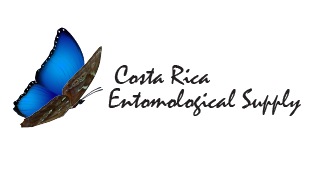I was fortunate enough to visit CRES in the beginning of January of 2016. This was my first trip to Costa Rica and I was excited to see what the country and this company had to offer. I am the entomologist/assistant curator at the new exhibit.
Butterfly Pavillion in Buena Park, California, and I was visiting to get to know breeders and exporters better to supply our large exhibit. I thought that I had a good idea of how Costa Rica bred butterflies since I visited many breeders on the island of Marinduque, Philippines in November of 2015, but this preconceived notion turned out to be far from reality. Compared to small family breeders in the Philippines earning very little per week, the breeders I visited that work with CRES were making a viable living and doing very well for themselves. From building new houses to starting additional companies, the Costa Rican breeders were proud to live the entrepreneurial lifestyle (something Costa Ricans are very proud of and strive for).
My favorite breeder we visited was the home of William Camacho. You will be hard pressed to find a more humble individual. What was once potrero (grazing land for cattle) 20 years ago, has been transformed by William’s kind hands back into a vibrant Costa Rican forest. His style of breeding was unique even among the skilled Costa Rican breeders in that he felt the healthiest and happiest pupae are bred in something as close to their natural habitat as possible. Because of this, William replicates as many conditions as he can from his observations of wild populations, from the amount of sunlight they prefer to what other species they interact with naturally.
Operations at the CRES headquarters were truly stunning as well. As someone who has seen first-hand how much work it takes for exhibits to display pupae and for breeders to raise healthy large quantities of butterflies, CRES operates at a level of selflessness that I do not think any other company in the world to date could replicate. Coordinating orders from dozens of international customers with their network of 80 families, all working within the confines of the unpredictable Mother Nature, is a daunting task that CRES seems to have conquered. What impressed me the most were their strict quality control standards for the pupae for export. Not only were they checked under a light for parasites, diseases, signs of early emergence, and general health, but they were also checked twice by two different employees. All of these checks went above and beyond the expected work, which speaks volumes about the quality of the resulting exported pupae.
My only complaint would be that quality control might be “too strict,” as many pupae are rejected during the sorting process for reasons I was often unable to see. CRES strives to sell as many pupae from as many of their breeders as possible, and I felt this level of quality control might limit what could be a larger income for the breeders and a large order for the customer. Nature is far from perfect, and I do not think that many of the rejected pupae would be a waste of money for the client. I understand that this level of quality is one of CRES’ differentiating factors, and it has obviously helped make them as successful as they are today.
The atmosphere among the breeders and staff at CRES was very welcoming and relaxed. I thoroughly enjoyed every minute of my time in Costa Rica and look forward to doing business with CRES in the future.
